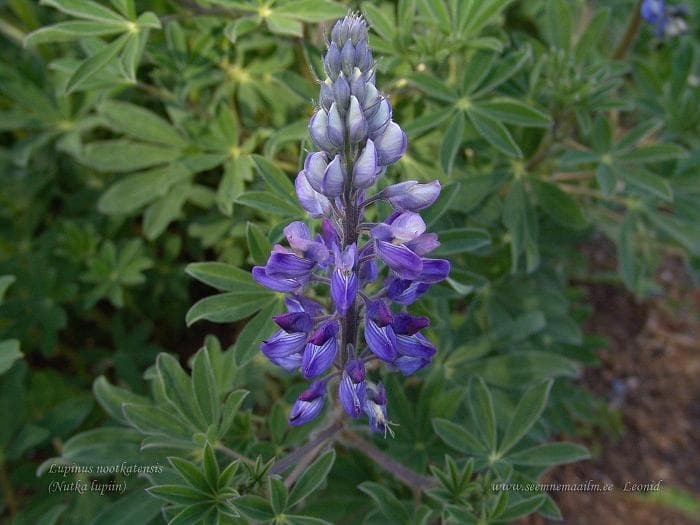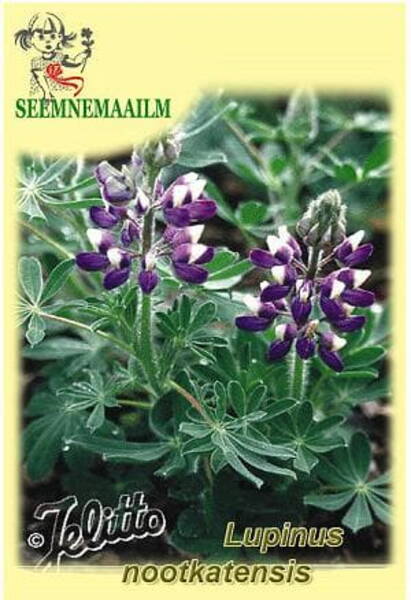Your shopping cart is empty!
Nootka lupine
Nootka lupine - Lupinus nootkatensis.
It grows in southeastern and central-eastern Alaska and the Aleutian Islands. It is similar to Lupinus arcticus, but reaches 40-90 cm in height and has shorter leaf petioles, blunt leaves, and numerous flower stalks. The pea-shaped pods are covered with small hairs.
Propagation: by seed.
Seeds sown outdoors germinate very quickly, usually within 7-10 days in moist conditions. However, seedlings do not like very cold weather, and early seedlings from seeds sown in the fall are likely to perish one by one in severe frosts. Seedlings grow to 2-3 cm before the formation of true leaves - then the cold can kill them.
In addition, seedlings will dry out if not provided with air cover immediately after they germinate. Fall sowing is much better if your area has no winter frosts, or you can cover them before a severe frost is forecast and then harvest them before the onset of spring. The seeds usually set fairly loosely.
Propagation: as with all legumes, you should thin out the seedlings early to prevent root disturbance (lupines also dislike root disturbance).
Let them now grow until they look like miniature lupines, usually until late spring if fall sowed. Once they reach this stage, they can be planted out in a small alpine bed, trough or pot where they will grow to maturity.
Lupines have a long taproot, so if you are growing them in a pot, try to make it quite deep.
Many lupins are short-lived, so collect seed to save...
Graham Nicholls writes that the lupins he has grown flowered in the first year before dying, so they may be monocarpic.
A sandy, well-drained, warm site suits these plants. Seedlings and young plants will dry out if overwatered.
Slugs attack lupins and can strip the stems in a short time. In indoor rock gardens, aphids and red spider mites are the worst pests. And where slugs stop, snails attack delphiniums.

Flowering pot plant; for the rockgarden;
VI-VII, Z3-6, 40 cm;
blue with white flag, soft haired foliage.
Family: Papilionaceae, Leguminosae
Origin: Alaska to British Columbia
Special Features: Bi-colored, blue and white blossoms with hairy stems
History: Introduced by JELITTO PERENNIAL SEED in 2003
Colour: Flowers are bicolored, purple-blue and white
Natural Flowering Period: June - July
Winter Hardiness Zones: Z3-6
Growth Habit: Low growing, clumping habit
Foliage: Beautiful velvety green palmate leaves
Height with Flower: 40 cm
Spacing between Plants: 30 cm
Soil Requirement: Performs best in acid soils; pH 5.5 - 6.8
Location: Sun to partial shade; prefers cool, moist summer climate
Use: Plant together in the border with Smyrnium perfoliatum, GERANIUM pratense "Striatum", and Euphorbia myrsinites
Specialities: Worthy candidate for container production
It grows in southeastern and central-eastern Alaska and the Aleutian Islands. It is similar to Lupinus arcticus, but reaches 40-90 cm in height and has shorter leaf petioles, blunt leaves, and numerous flower stalks. The pea-shaped pods are covered with small hairs.
Propagation: by seed.
Seeds sown outdoors germinate very quickly, usually within 7-10 days in moist conditions. However, seedlings do not like very cold weather, and early seedlings from seeds sown in the fall are likely to perish one by one in severe frosts. Seedlings grow to 2-3 cm before the formation of true leaves - then the cold can kill them.
In addition, seedlings will dry out if not provided with air cover immediately after they germinate. Fall sowing is much better if your area has no winter frosts, or you can cover them before a severe frost is forecast and then harvest them before the onset of spring. The seeds usually set fairly loosely.
Propagation: as with all legumes, you should thin out the seedlings early to prevent root disturbance (lupines also dislike root disturbance).
Let them now grow until they look like miniature lupines, usually until late spring if fall sowed. Once they reach this stage, they can be planted out in a small alpine bed, trough or pot where they will grow to maturity.
Lupines have a long taproot, so if you are growing them in a pot, try to make it quite deep.
Many lupins are short-lived, so collect seed to save...
Graham Nicholls writes that the lupins he has grown flowered in the first year before dying, so they may be monocarpic.
A sandy, well-drained, warm site suits these plants. Seedlings and young plants will dry out if overwatered.
Slugs attack lupins and can strip the stems in a short time. In indoor rock gardens, aphids and red spider mites are the worst pests. And where slugs stop, snails attack delphiniums.

Flowering pot plant; for the rockgarden;
VI-VII, Z3-6, 40 cm;
blue with white flag, soft haired foliage.
Family: Papilionaceae, Leguminosae
Origin: Alaska to British Columbia
Special Features: Bi-colored, blue and white blossoms with hairy stems
History: Introduced by JELITTO PERENNIAL SEED in 2003
Colour: Flowers are bicolored, purple-blue and white
Natural Flowering Period: June - July
Winter Hardiness Zones: Z3-6
Growth Habit: Low growing, clumping habit
Foliage: Beautiful velvety green palmate leaves
Height with Flower: 40 cm
Spacing between Plants: 30 cm
Soil Requirement: Performs best in acid soils; pH 5.5 - 6.8
Location: Sun to partial shade; prefers cool, moist summer climate
Use: Plant together in the border with Smyrnium perfoliatum, GERANIUM pratense "Striatum", and Euphorbia myrsinites
Specialities: Worthy candidate for container production
Cultural Tips:
Grams per 1000 seeds: 12,5
Seeds per Gram: 80
Seeding Recommendation: 30 g / 1000 plants
Sowing Rate: 2 seeds per cell
Plug tray recommended size(s): 72 or 128
Germination: Rapidly germinating, keep seed in constant moisture (not wet) with temperatures of about +20°C. Seeds must be covered thinly. Keep in cooler conditions after germination occurs. The germination might be slower and more irregular. This poses no problems.
Scheduling:
Best Sowing Dates: Anytime
Sowing to Germination: 2 - 3 weeks
Germination to Transplant: 4 - 8 weeks
Transplanting to Salable Plant: 6 - 10 weeks
Cutting-Back at Transplanting: Not Necessary.












